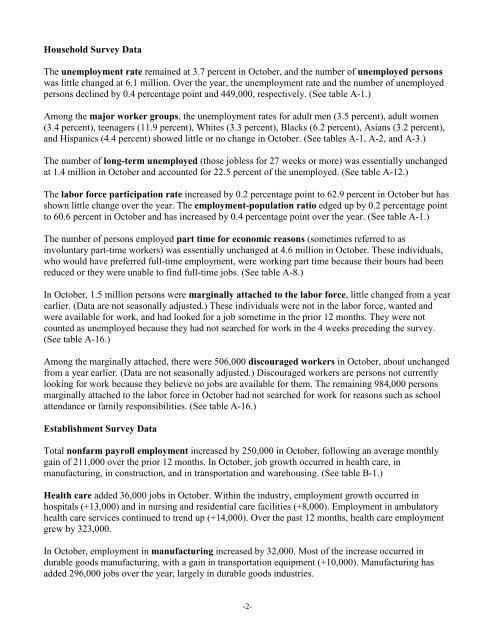Hidden Unemployment
Hidden Unemployment
Hidden Unemployment
Create successful ePaper yourself
Turn your PDF publications into a flip-book with our unique Google optimized e-Paper software.
Household Survey Data<br />
The unemployment rate remained at 3.7 percent in October, and the number of unemployed persons<br />
was little changed at 6.1 million. Over the year, the unemployment rate and the number of unemployed<br />
persons declined by 0.4 percentage point and 449,000, respectively. (See table A-1.)<br />
Among the major worker groups, the unemployment rates for adult men (3.5 percent), adult women<br />
(3.4 percent), teenagers (11.9 percent), Whites (3.3 percent), Blacks (6.2 percent), Asians (3.2 percent),<br />
and Hispanics (4.4 percent) showed little or no change in October. (See tables A-1, A-2, and A-3.)<br />
The number of long-term unemployed (those jobless for 27 weeks or more) was essentially unchanged<br />
at 1.4 million in October and accounted for 22.5 percent of the unemployed. (See table A-12.)<br />
The labor force participation rate increased by 0.2 percentage point to 62.9 percent in October but has<br />
shown little change over the year. The employment-population ratio edged up by 0.2 percentage point<br />
to 60.6 percent in October and has increased by 0.4 percentage point over the year. (See table A-1.)<br />
The number of persons employed part time for economic reasons (sometimes referred to as<br />
involuntary part-time workers) was essentially unchanged at 4.6 million in October. These individuals,<br />
who would have preferred full-time employment, were working part time because their hours had been<br />
reduced or they were unable to find full-time jobs. (See table A-8.)<br />
In October, 1.5 million persons were marginally attached to the labor force, little changed from a year<br />
earlier. (Data are not seasonally adjusted.) These individuals were not in the labor force, wanted and<br />
were available for work, and had looked for a job sometime in the prior 12 months. They were not<br />
counted as unemployed because they had not searched for work in the 4 weeks preceding the survey.<br />
(See table A-16.)<br />
Among the marginally attached, there were 506,000 discouraged workers in October, about unchanged<br />
from a year earlier. (Data are not seasonally adjusted.) Discouraged workers are persons not currently<br />
looking for work because they believe no jobs are available for them. The remaining 984,000 persons<br />
marginally attached to the labor force in October had not searched for work for reasons such as school<br />
attendance or family responsibilities. (See table A-16.)<br />
Establishment Survey Data<br />
Total nonfarm payroll employment increased by 250,000 in October, following an average monthly<br />
gain of 211,000 over the prior 12 months. In October, job growth occurred in health care, in<br />
manufacturing, in construction, and in transportation and warehousing. (See table B-1.)<br />
Health care added 36,000 jobs in October. Within the industry, employment growth occurred in<br />
hospitals (+13,000) and in nursing and residential care facilities (+8,000). Employment in ambulatory<br />
health care services continued to trend up (+14,000). Over the past 12 months, health care employment<br />
grew by 323,000.<br />
In October, employment in manufacturing increased by 32,000. Most of the increase occurred in<br />
durable goods manufacturing, with a gain in transportation equipment (+10,000). Manufacturing has<br />
added 296,000 jobs over the year, largely in durable goods industries.<br />
-2-

















